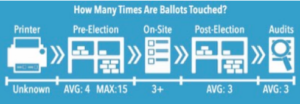The Big Four Blog Series: Chain of Custody
& Why it Matters
According to NIST (The National Institute for Standard and Technology) chain of custody is defined as:
“A process that tracks the movement of evidence through its collection, safeguarding, and analysis lifecycle by documenting each person who handled the evidence, the date/time it was collected or transferred, and the purpose for the transfer.” –NIST Computer Security Resource Center.
 Think chain-of-custody doesn’t apply in the “real world”?
Think chain-of-custody doesn’t apply in the “real world”?
In fact, there are “chains of custody” all around us. When you dine at a restaurant and the bill is provided, you willingly hand over your credit card and entrust the waiter to handle confidential information with the utmost care. There is no guarantee that the right bill is being charged, the employees are not recording your credentials, or that they will safely return your card to the right table.
Whether we encounter chain of custody within our work as election officials or in our day to day lives, one thing remains true: Any time there is a “hand off” in a process, or where there is a lack of visibility, there is also vulnerability. Our goal, in the election space, is to reduce the vulnerabilities and document our process to the best of our ability.
When it comes to moving our election machines, equipment and ballots, the goal is to have a fully traceable audit trail. We should want to know WHO touched WHAT, WHEN did they touch it, and WHERE did it go. This should be kept in a safe, secure repository – not only for our own confidence – but to care for future audits.

Having this practice in place enables us to know that our election machines were transported from a safe and secure environment, through a safe and secure transportation process, to a safe and secure election location.
Similar to handing over your card to pay for a meal, the importance of the handoff is also demonstrated in sports. If relay racers don’t navigate the baton exchange well, the race is lost – even if they are the fastest runners on earth. You may have an MVP level quarterback and running back on your football team, but a fumbled handoff could still cost your team the entire game. Coordinating the hand off is critical! Winning teams-and workplaces- recognize, prioritize, and practice these important exchanges over and over again til their methods are perfected.
We kicked off our Big Four blog series by introducing a familiar “elephant in the room” scenario. Here comes the elephant, the one we’ve accommodated for so long, because of its sheer size. Implementing a chain of custody process can seem daunting – especially if you are chained to your existing processes.
As intimidating as it may seem, if you don’t currently have systems in place for chain of custody within your processes as an election official, there’s no time to waste. This is a critical area 
which needs immediate attention. As we are all aware, one “black eye” in this space casts a shadow of doubt on our entire election security environment.
Take some time to review your current chain of custody processes. Identify places where old processes are no longer working or are no longer adequate. Bring your entire team on board by making chain of custody a shared responsibility and prioritizing it for your next election cycle.Together we can work to safeguard vulnerable areas of the elections process through enhanced chain of custody procedures and processes.
This has been the second installment of our Big Four blog series. Don’t miss our next installment as we discuss the value and impact of creating a sense of urgency within your elections processes.
We look forward to digging deeper into this topic soon. Stay tuned!